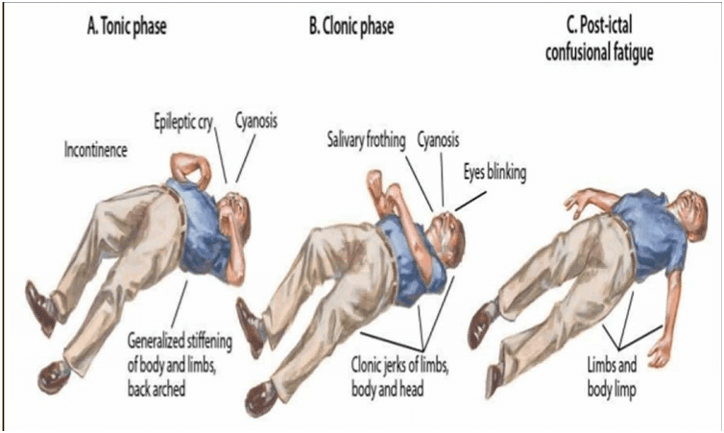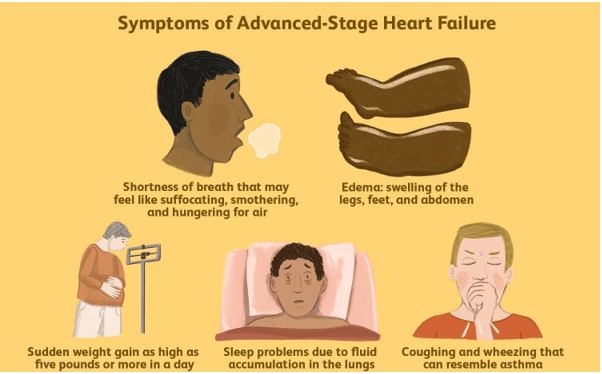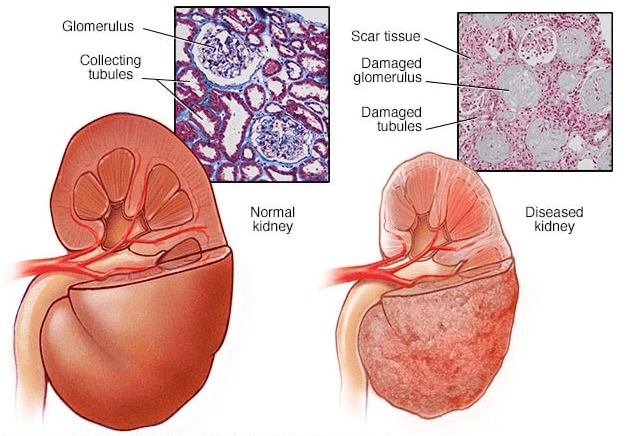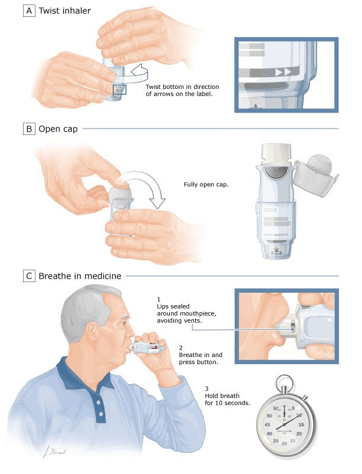PN Comprehensive Predictor PN 2020
PN Comprehensive Predictor PN 2020
Total Questions : 180
Showing 10 questions Sign up for moreA nurse is caring for a 3-year-old child immediately following a tonic-clonic seizure.
Which of the following actions should the nurse take?
Explanation
After a tonic-clonic seizure, the nurse should first check the child for any injuries, particularly in the oral cavity. This is because during a seizure, the child's tongue may have been biten, or there may be other oral injuries. Therefore, it is essential to check the oral cavity for any injury or bleeding.

A nurse is caring for a client who has paranoid schizophrenia and believes that they are being followed by FBI agents who are pretending to be psychiatric staff.
Which of the following responses should the nurse make?
Explanation
b. This must be very frightening for you. Let's talk more about it.
It is important for the nurse to acknowledge the client's fears and show empathy towards them. By saying "This must be very frightening for you," the nurse validates the client's feelings and shows that they are being heard.
Additionally, by suggesting that they talk more about it, the nurse can work towards building a therapeutic relationship with the client and gain more insight into their thought processes.
The other options are not appropriate because:
a. The nurse should not deny the client's beliefs or try to convince them that they are wrong. This can cause
the client to feel invalidated and may make them less likely to trust the nurse.
c. While it is important to understand the client's perspective, this question may come off as confrontational and accusatory.
d. Similarly, this question may be perceived as confrontational and may make the client defensive. It is important to approach the client with empathy and understanding rather than skepticism.

A nurse is reinforcing teaching about advance directives with a client who has end-stage heart failure.
Which of the following statements by the client indicates an understanding of the teaching?
Explanation
a. "I should discuss this document with my family after I sign it"
Advance directives are legal documents that allow an individual to specify the type of medical care they want to receive in case they become unable to make their own decisions. It is important for the client to discuss their wishes with their family members or loved ones so that they are aware of the client's desires and can act accordingly in case of an emergency.
b. "I am not allowed to change my mind once I sign this document" is incorrect. The client can change their mind about their advance directive at any time and for any reason. It is important for the client to review their advance directive periodically and make changes as necessary.
c. "An atorney will need to notarize this document for it to be valid" is also incorrect. While some states require advance directives to be notarized or witnessed, not all states do. It is important for the client to check with their state's laws regarding advance directives to ensure that their document is legally binding.
d. "My partner needs to be present when I sign this document" is not necessarily true. While it is recommended for the client to have a witness present when signing their advance directive, it does not have to be their partner. The witness should be someone who is not a family member, healthcare provider, or beneficiary of the client's estate.

A nurse is reinforcing teaching with a client who has diabetes mellitus about a 24-hour creatinine clearance test.
Which of the following statements should the nurse include in the teaching?
Explanation
C, "You can begin collection of urine after discarding your first morning void."
A 24-hour creatinine clearance test is used to evaluate how well the kidneys are functioning by measuring the amount of creatinine in the blood and urine over a 24-hour period. During the test, the client is asked to discard their first morning void and then collect all urine for the next 24 hours.
Option A is incorrect because a protein-rich diet can affect the creatinine levels in the urine, which can result in inaccurate test results. Therefore, the nurse should advise the client to avoid a protein-rich diet during the collection period.
Option B is incorrect because blood glucose levels are not relevant to a 24-hour creatinine clearance test. Therefore, the nurse should not ask the client to record their blood glucose level each time they void.
Option D is incorrect because using an antiseptic towel to cleanse the perineal area can also affect the test results by introducing contaminants into the urine sample. Therefore, the nurse should advise the client to cleanse the perineal area with soap and water or an alcohol wipe.

A nurse in an adult day care facility is contributing to the plan of care for a client whose family reports recent confusion and memory loss.
Which of the following strategies should the nurse include in the plan?
Explanation
A. Maintain low-level lights in common areas.Low-level lighting can increase confusion and the risk of falls, especially for clients with memory loss. It is important to have adequate lighting to promote a safe environment and help with orientation. Well-lit areas can reduce disorientation and anxiety in clients who are confused or have memory issues.
B. Give the client several meal options at lunchtime. For clients with memory loss and confusion, it is better to provide simple choices or pre-selected meals to reduce decision-making stress and confusion.
C. Confront the client regarding inappropriate behavior.Confronting a client with memory loss or confusion about inappropriate behavior can increase agitation, anxiety, and defensive reactions.
D. Use symbols in the communal room signage.Symbols and pictures can help clients with memory loss navigate their environment more easily because they may have difficulty reading or comprehending written language. Visual cues such as symbols in signage can improve orientation and independence, helping the client feel more comfortable in their surroundings.
A nurse is caring for a client who has a prescription for acetaminophen 300 mg with codeine 30 mg, 1 tablet every 3 to 4 hours PRN for pain.
The nurse inadvertently administers 2 tablets to the client. In which of the following locations should the nurse document this alert care incident?
Explanation
a. Incident report.
Whenever a medication error occurs, it should be documented in an incident report. The purpose of the incident report is to document the details of the event, including what happened, why it happened, and what was done to prevent it from happening again. Incident reports are not part of the client's medical record and are not used for disciplinary action. They are used for quality improvement and risk management purposes.
The nursing care plan is a document that outlines the client's nursing care needs and interventions. It is not the appropriate place to document a medication error.
The controlled substance inventory record is used to document the administration and dispensing of controlled substances. It is not the appropriate place to document a medication error.
The provider's progress notes document the provider's assessment, diagnosis, and treatment plan for the client. They are not the appropriate place to document a medication error.


A nurse is caring for a client who follows a kosher diet. Which of the following menu items should the nurse include on the tray?
Explanation
c. Roasted salmon
The nurse should include roasted salmon on the tray for the client who follows a kosher diet.
Kosher dietary laws prohibit the consumption of shellfish such as clams and shrimp, as well as pork products like pulled pork sandwiches. Roasted salmon, on the other hand, is a permissible food item in a kosher diet.
It's important for the nurse to be aware of the client's dietary restrictions and preferences to ensure that they receive appropriate and culturally sensitive care.
A nurse is caring for a client who has end-stage kidney disease. The client has decided to stop dialysis treatment.
Which of the following actions should the nurse take?
Explanation
a. Support the client's decision to stop the treatment.
As a nurse, it is important to respect the client's autonomy and right to make decisions about their own care. The decision to stop dialysis treatment is a personal one and should be respected by the healthcare team. The nurse should support the client's decision and provide information and resources to help the client manage symptoms and maintain comfort during the end-of-life process.
It is not appropriate for the nurse to suggest that the client discuss the decision with her family or to discuss alternative treatment methods, as these decisions should be made by the client in conjunction with their healthcare provider.
It may be appropriate to offer spiritual or emotional support to the client, but this should be based on the client's preferences and not imposed upon them by the healthcare team.

A nurse is reinforcing teaching with a client who is about to start using an albuterol metered-dose inhaler.
Which of the following instructions should the nurse include in the teaching?
Explanation
Albuterol is a bronchodilator medication that is commonly delivered through a metered-dose inhaler (MDI) to treat asthma and other respiratory conditions. Proper inhaler technique is crucial for effective delivery of the medication to the lungs.
Option (a) is incorrect because the client should actually tilt their head back slightly and breathe out fully before inhaling the medication.
Option (b) is incorrect because the client should take a slow, deep breath in while depressing the canister once.
Option (d) is incorrect because the client should hold their breath for 10 seconds after inhaling the medication to allow it to reach the lungs.
Therefore, the correct instruction for the nurse to include in the teaching is to instruct the client to close their mouth around the mouthpiece of the inhaler to ensure that the medication is delivered directly to the lungs.

A nurse is reinforcing teaching with a new parent about bathing her newborn.
Which of the following statements should the nurse include?
Explanation
Explanation:
Sponge baths are recommended until the umbilical cord stump falls off, which typically occurs within the first two weeks of life. After that, the baby can be immersed in water for a regular bath.
Using talcum powder is not recommended as it can be harmful to the baby's respiratory system if inhaled. Mild, pH-balanced soap should be used instead of alkaline soap to avoid irritating the baby's delicate skin.
The bathwater temperature should be around 98 degrees Fahrenheit and not hoter than 100 degrees Fahrenheit to prevent burns.

You just viewed 10 questions out of the 180 questions on the PN Comprehensive Predictor PN 2020 Exam. Subscribe to our Premium Package to obtain access on all the questions and have unlimited access on all Exams. Subscribe Now



